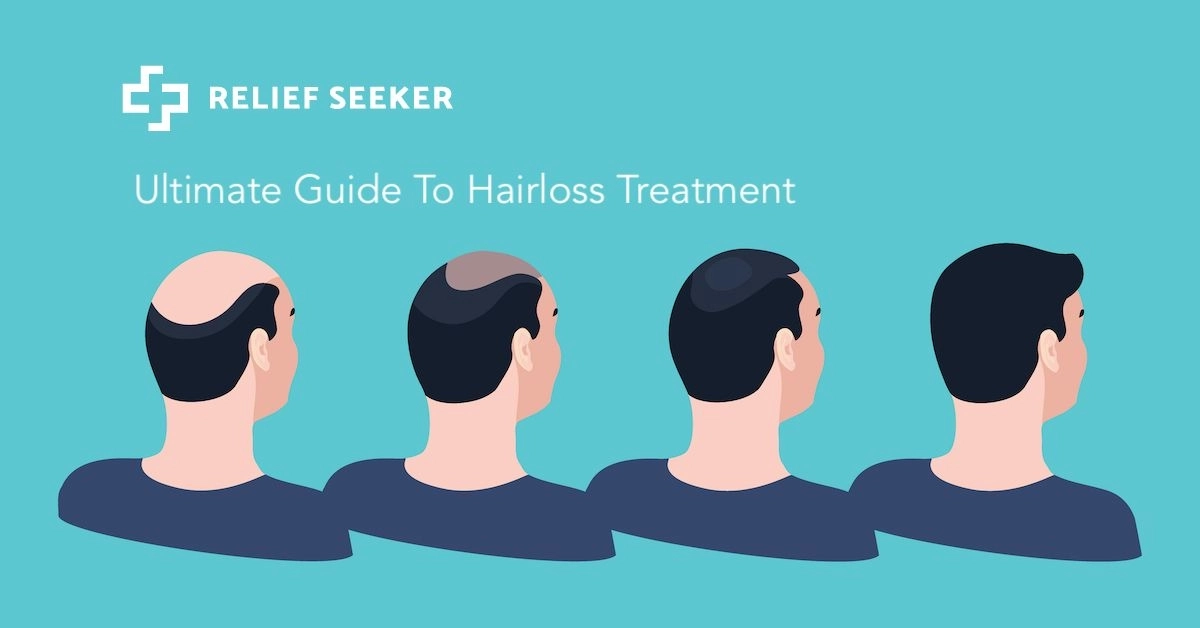What Exactly Is Hair Loss?
In order to understand hair loss, it is important to first learn where your hair comes from. Through the production of androgen hormones throughout your body, the follicles under your skin will begin to produce hair. On average most individuals possess roughly 100,000 – 150,000 hairs on their scalp. Each of these hairs will have an average life cycle of roughly 2-6 years. Once fully grown, a hair will rest for a number of months before falling out, at which point that follicle will produce new hair. When an individual begins to exceed the normal 50-100 strands shed each day, you may be experiencing some form of alopecia.
Hair loss, or Alopecia, is defined as the complete or partial loss of hair on the head or body, which can be temporary or permanent. The most common form of alopecia gradually affects the scalp over time and is often referred to as balding. While hair loss can affect both men and women of all ages and in many different ways, it does occur most often in aging men. Given the level of variation in the manner with which hair loss can present itself, it is important to have as much information as possible so that you may better understand and identify the type of hair loss you are experiencing.
The different types of hair loss include:
- Androgenic Alopecia
- Alopecia Areata & Ophiasis
- Alopecia Totalis
- Alopecia Universalis
- Traction Alopecia & Chignon Alopecia
- Hypotrichosis
- Telogen Effluvium
- Trichotillomania
- 65Folliculitis
Symptoms and Causes of the Different Types of Hair Loss
While the symptoms of hair loss may seem like a rhetorical topic, the different types of hair loss can present unique variations with regard to the area of the body affected, the permanence of the hair loss, quantity of hair loss, the pattern of the hair loss, and the accompaniment of certain non-hair related symptoms. The following will provide a brief breakdown of the different variations of hair loss and how they can be identified.
Androgenic Alopecia
- Symptoms
Androgenic Alopecia is the most common variation of hair loss in the United States, affecting roughly 80 million men and women. This type of hair loss can be referred to as pattern baldness, given the specific areas of the scalp subject to lack of growth, which creates a predictable ‘pattern’. In men, this male pattern baldness will begin to affect either the area of the scalp directly above the temples and as the hairline recedes over time, it will create a distinct “M” pattern. It is also likely that this brand of hair loss with be accompanied by thinning of hair around the top (crown) of the head, typically leading to complete or partial baldness. In females, this pattern baldness will likely result in a thinning of all hair and very rarely leads to complete baldness.
- Causes
While it is still undetermined exactly what causes androgenic alopecia, it is widely accepted that a number of genetic and environmental factors contribute to the development of the condition. It is known that this form of hair loss is somehow related to androgen hormones, which are responsible for sexual development and hair growth in men.
Alopecia Areata/Alopecia Totalis/Alopecia Universalis
- Symptoms
The three variations of alopecia areata are alopecia areata patchy, alopecia totalis, and alopecia universalis. Alopecia areata patchy can be characterized by one or more small, circular, hairless patches on the scalp, face, or rest of the body. Alopecia totalis can be characterized by a complete loss of hair localized to the scalp. Alopecia universalis is a condition resulting in complete loss of hair across the entire body. Additional symptoms may include rapid hair loss, hair loss on one side of the head, rows of small dents on the fingernails, hair loss, and growth occurring simultaneously at different spots on the body. A unique variation of alopecia areata, known as Ophiasis occurs when the hair loss creates a wave-like pattern around the scalp.
- Causes
Alopecia areata is a complex autoimmune disease in which your body mistakes normal, healthy cells as harmful, and begins attacking these cells. Unfortunately, research has been inconclusive as to what exactly causes the immune system to destroy healthy hair follicles. The current understanding is that it is some combination of genetics and the environment.
Traction Alopecia & Chigon Alopecia
- Symptoms
The most common sign of Traction Alopecia and/or Chigon Alopecia is a slow loss of hair overtime on the scalp. Traction alopecia will cause thinning of the hair either at the hairline or throughout the entire scalp, whereas chigon alopecia typically results in hair loss at the crown of the head.
- Causes
When the hair receives constant tension or is continuously pulled over extended periods of time, this may cause damage to the hair follicle. Individuals who constantly wear hats, tightly wound braids/cornrows, tight buns/ponytails, and even those who have received facelift may experience an amount of tension that could result in hair loss
Hypotrichosis
- Symptoms
Hypotrichosis can be characterized by extremely little or no hair growth across the entire body where an individual would typically grow hair. Where those afflicted with alopecia areata will lose the hair they once had, individuals diagnosed with Hypotrichosis will have had no hair to begin with.
- Causes
Hypotrichosis is a rare congenital defect present at birth which causes a mutation of the cells within hair follicles. This mutation will typically result in abnormal, underdeveloped, or no hair growth across the body.
Telogen Effluvium
- Symptoms
Telogen Effluvium will typically present itself in the form of excess thinning and/or shedding of the hair on the scalp.
- Causes
Telogen is defined as the resting phase for hair, shortly after which it will begin to naturally shed. Trauma, stress, chronic illness, medication, surgery, and excessive exposure to the sun can all lead to the expedition of your hairs life cycle, which will result in losing hair quicker than it can regrow.
Trichotillomania
- Symptoms
Trichotillomania is the obsessive-compulsive need to constantly pluck out one’s own hair. Depending on the individual, this hair loss can occur anywhere across the body. The most common area of the body affected by individuals with Trichotillomania is the face and head; scalp, eyebrow, beard, eyelashes, etc.
- Causes
The leading cause of Trichotillomania is stress or anxiety, though other factors may be at play. Obsessive-compulsive disorder, changing hormone levels, and depression may also lead an individual to develop Trichotillomania.
Folliculitis
- Symptoms
Individuals with Folliculitis will typically show groups of red bumps or pimples around hair follicles, blisters, itching skin, tender skin, burning skin, or a large swollen bump on the skin. While this condition is typically insignificant it can lead to the infection of hair follicles causing them to easily fall out wherever they occur on the body.
- Causes
Folliculitis is typically caused by a virus, fungi, inflammation of ingrown hair, or most commonly when a hair follicle develops a staph infection.
Treatments For Hair Loss
Depending on the cause of your hair loss, there are a number of options available to you through digital clinics as well as your primary care physician.
Rogaine
Rogaine is the brand name for the over-the-counter drug Minoxidil. Minoxidil will come as either a liquid or foam that is to be massaged on to your scalp every day. While in some cases this product may result in short-term additional hair loss, in order to receive the full benefits, the routine application is required to prevent further loss and begin new hair growth.
Propecia
Propecia is the brand name for the prescription drug Finasteride. Finasteride is a pill designed specifically for men in order to stem the rate of hair loss and potentially develop new growth. This medication is to be taken on a daily basis in order to see the most positive results. Research has also shown that Finasteride may have a decreased effect on men over the age of 60.
Hair Transplant
Although this may be too invasive of an option for some, it does present marked results when properly executed. Given that hair loss on the top of the head is an extremely common variation of hair loss, this surgery aims to take advantage of the healthy hair on other areas of your scalp. Your surgeon will remove multiple hair follicles from the back of your head and implant them in the affected area atop your scalp. It is often recommended that Minoxidil or Finasteride (for men) be taken to maximize results after the surgery.
Laser Therapy
A relatively new treatment for hair loss is the use of laser therapy. These red lights emit photons into the scalp tissue which are absorbed by weak cells in order to promote hair growth. While the long-term benefits of this procedure are still unknown, there is no doubt that it is far safer and less invasive than a hair transplant surgery.
Side Effects of Treatment for Hair Loss
The various forms of treatment for hair loss come with their own risk for potential side effects. Any liquid or foam treatment may present irritation of the skin, unwanted hair growth on face and hands, and rapid heart rate. The pill form of treatment, Finasteride, may present a weakened sex drive, erectile dysfunction, and an increased risk of prostate cancer. As with any surgery, the major side effects of hair transplant surgery include excessive bleeding and scarring. Given that laser therapy for hair loss is such a young course of treatment, the long-term negative side effects have yet to be established.
Where to get Treatment for Hair Loss
While you can visit your primary care physician to discuss the possible options for treatment of your hair loss, there are a number of digital clinics available who can provide individuals with discreet, convenient, and affordable treatment. The following digital clinics can offer you discreet access to a licensed physician who can have your hair loss treatment delivered directly to your door in discreet packaging:
Nowadays, you can get hair loss treatment online. Just fill out a quick survey, consult a doctor, and they'll prescribe and deliver medication discreetly to your home. We reviewed and ranked the Best Hair Loss Treatment Online.
Key Takeaways Regarding Hair Loss Treatment
Remember that you are not alone. Roughly 50 million men and 30 million women suffer from some sort of hair loss in the United States. While some types of hair loss are simply a natural biological process of aging, there may be other factors at play, and it’s important to understand the symptoms you may have. Take full advantage of the resources available to you and know, that treatment for your hair loss is just a click away. Please explore the digital clinics above and begin your search to a happier and more confident version of yourself that you deserve.


